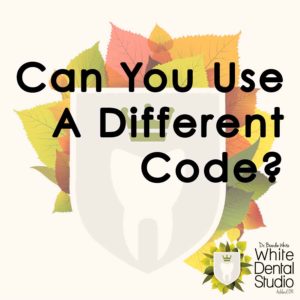 On the subject of insurance, many people are aware of the concept of “coding” insurance claims. In short, by sending an insurance company a particular series of letters and numbers (code) along with the charge for a procedure, the person submitting the claim is able to inform an insurance company of what treatment a dental or medical practice has completed for their patient. Even though the concept of needing a code when submitting to insurance is understood by most, unless you’ve worked in the financial side of healthcare you probably don’t know how or why insurance billers and coders choose the codes they do, or how dental coding and medical coding differ.
On the subject of insurance, many people are aware of the concept of “coding” insurance claims. In short, by sending an insurance company a particular series of letters and numbers (code) along with the charge for a procedure, the person submitting the claim is able to inform an insurance company of what treatment a dental or medical practice has completed for their patient. Even though the concept of needing a code when submitting to insurance is understood by most, unless you’ve worked in the financial side of healthcare you probably don’t know how or why insurance billers and coders choose the codes they do, or how dental coding and medical coding differ.
After receiving a dental insurance denial, I’ve often been asked by patients, “Can you use a different code?” Having done both medical and dental billing, I understand why people ask that question. Medical coding is very complex. There are literally tens of thousands of ICD-10 codes (diagnosis codes) that you have to couple with CPT codes (codes that describe what procedures were done) to correspond with medical treatment. There are times an insurance biller may submit a claim with codes that seem appropriate, receive a denial, and then based on that denial realize that another code was actually more accurate or descriptive of the treatment and so they are able to resubmit with a new code to get reimbursement. A lot of patients have heard of “using a different code” to gain insurance payment because that tactic can work in medical billing. In fact, insurance companies will sometimes tell a frustrated policy holder that they should have their doctors’ office submit with a different code in order to reverse a benefits denial.
While there are tens of thousands of ever evolving codes in the medical insurance world, by comparison, there are merely hundreds in the dental insurance arena. With dental claims there is no reading chart notes and then scouring the ICD-10 and CPT code books to try to find diagnosis and procedure codes which fit the treatment the doctor has described. If Dr. White tells me that he did a prep for a full zirconia (ceramic) crown on tooth #14, there is literally only one code that I could possibly use for that, and it is pretty easy to locate in a CDT dental coding book by looking in the section for crown treatment codes. For a zirconia crown, I would submit the claim with code D2740 to tell the insurance company we prepared the tooth for a porcelain/ceramic crown. Changing to any other code would be not only inaccurate, but fraudulent if done intentionally. For example, if I were to instead submit code D2790, which is a code that corresponds with a full cast high noble metal crown (gold crown), it would clearly be an incorrect code. Should I do this intentionally for the purpose of gaining additional benefit from insurance, it would be considered insurance fraud, so it is of extreme importance to submit the correct code which corresponds with the actual treatment completed and to quickly correct the claim if it is discovered an error has been made.
Dental codes are pretty cut and dried: Did you have a three surface composite filling completed? There’s a code for that. Did you have a nightguard made by your dentist to keep you from grinding your teeth at night? There’s a code for that. How about if you have the roots of a broken tooth removed? There’s a code for that, too. In most cases, finding the right dental code is fairly easy and there aren’t very many situations where changing a code would be the helpful or accurate thing to do. Of course, the dental code itself doesn’t always give all of the information that your insurance company may require. But, unlike medical insurance claims where it might mean searching for additional diagnosis or modifying codes to add to the claim, the person handling claims at your dental practice may instead need to send additional documentation to your carrier. This may include things like x-rays, photos, or notes.
Overall, dental coding may be much simpler than medical, but it is still very helpful to have an experienced dental team on your side to help you maximize your dental benefit. Processing claims and getting the best reimbursement goes beyond just knowing the right code, and can sometimes present challenges. At White Dental Studio, we do our very best to assist our patients in overcoming those hurdles. We don’t want insurance dictating your treatment – we want to help you make the best decisions for your oral health.
I hope you’ve enjoyed this blog post, and please let me know if there are other insurance or dental management subjects you would like to hear more about!
Post written by: Erin Englehart, Office Manger Extraordinaire at White Dental Studio in Ashland, OR.
Other posts by Erin:
What Are Usual and Customary Rates?
Dental Insurance, Should I Purchase It? The Answer Might Surprise You
Dental Insurance: Understanding Your Maximum

Recent Comments